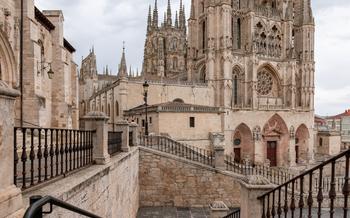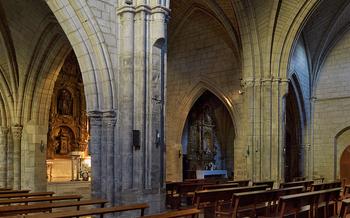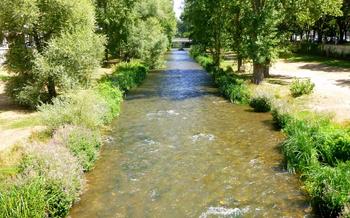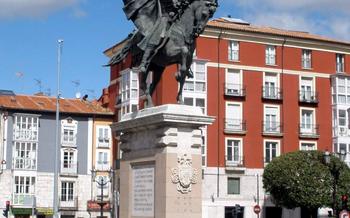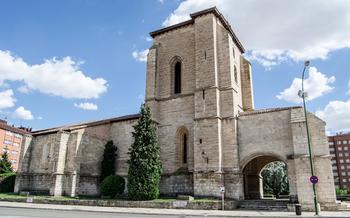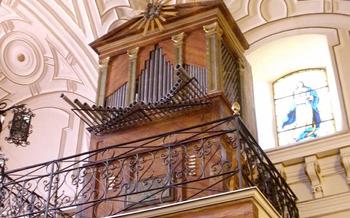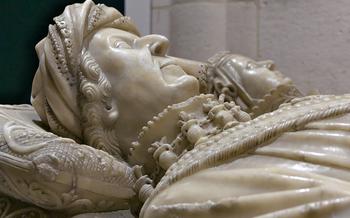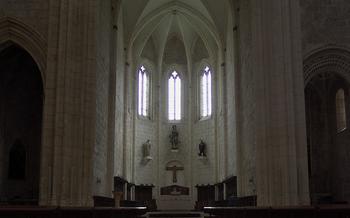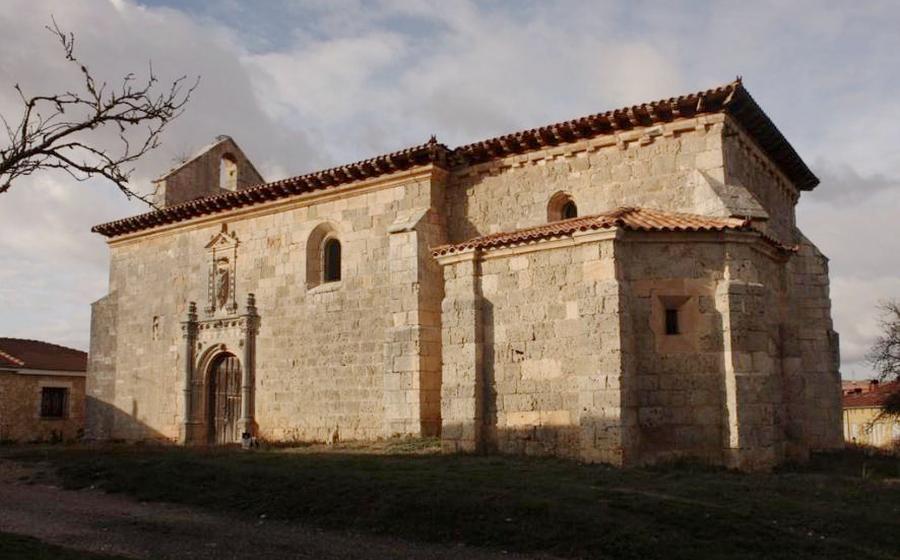
Iglesia de San Román
- Iglesia de San Román: A Monumental Treasure in Burgos
- Architectural Masterpiece: A Fusion of Styles
- Pilgrimage Destination: On the Camino de Santiago
- Royal Connection: A Place of Power
- Resting Place of El Cid: A National Hero
- Hidden Treasures: Beyond the Main Altar
- A Place of Worship: Experiencing Spirituality
- Photography and Art Appreciation
- Accessibility for All: Ensuring Inclusivity
- Local Festivals and Events: A Time for Celebration
- Surrounding Attractions: Exploring Burgos
- Insider Tip: A Secret Viewpoint
Iglesia de San Román: A Monumental Treasure in Burgos
Standing tall as a testament to architectural prowess, the Iglesia de San Román is a must-visit gem in the heart of Burgos, Spain. This monumental church, rooted in the 13th century, exudes a harmonious blend of Romanesque and Gothic elements, earning its status as a designated Spanish Historical-Artistic Monument. Located conveniently within the historic city center, the church beckons visitors with its rich history, artistic wonders, and deep-seated connection to the essence of Burgos.
Enter the hallowed halls of this architectural masterpiece, and be greeted by an awe-inspiring display of intricate carvings adorning the exterior. The church's distinctive tower, a beacon of elegance, pierces the skyline, while the interior unfolds a tapestry of vaulted ceilings, graceful columns, and ornate embellishments that transport visitors to a bygone era. Discover hidden architectural gems, each whispering tales of the church's storied past, and immerse yourself in the captivating narratives etched within its very walls.
Architectural Masterpiece: A Fusion of Styles
The Iglesia de San Román stands as a testament to the architectural prowess of the Middle Ages, seamlessly blending Romanesque and Gothic elements to create a harmonious and visually stunning masterpiece. Its exterior captivates with a distinctive tower, rising proudly above the surrounding cityscape. Intricate carvings adorn the tower's surface, depicting biblical scenes and mythical creatures with remarkable detail.
Step inside, and the church's interior reveals a symphony of vaulted ceilings and graceful columns. The soaring arches, supported by sturdy pillars, create an atmosphere of awe and reverence. Admire the intricate carvings that embellish the capitals, each one narrating stories from the Bible and the lives of saints.
Among the hidden architectural gems of the church are its side chapels, each showcasing unique features and artistic treasures. Discover the Chapel of the Annunciation, where delicate frescoes depict the angel Gabriel's visit to Mary. In the Chapel of the Holy Cross, marvel at the intricately carved wooden altarpiece, a testament to the skill of medieval artisans.
Explore the church's cloister, a tranquil oasis adorned with serene arches and delicate carvings. This hidden sanctuary offers a glimpse into the monastic life of the past, where monks sought solace and contemplation amidst the beauty of their surroundings.
Pilgrimage Destination: On the Camino de Santiago
The Iglesia de San Román a network of paths leading to the Cathedral of Santiago de Compostela in Galicia, where the remains of Saint James the Great are said to be buried. For centuries, pilgrims from across Europe have journeyed along these routes, seeking spiritual enlightenment and redemption.
The church served as a crucial stop for pilgrims, providing shelter, sustenance, and guidance. Its strategic location along the Camino allowed weary travelers to rest, replenish their supplies, and seek solace in prayer. The church's proximity to the city center also enabled pilgrims to explore Burgos's other religious and cultural landmarks.
Throughout history, the church has witnessed countless stories of devotion, struggle, and transformation as pilgrims shared their experiences and sought divine guidance. Legends and anecdotes abound, recounting miraculous interventions, unexpected encounters, and the profound spiritual growth that unfolded within the church's hallowed walls.
The Camino de Santiago has left an indelible mark on the church's character, shaping its development and infusing it with a sense of sacredness and purpose. To this day, the church continues to welcome pilgrims from all walks of life, offering a sanctuary for reflection, renewal, and connection to a centuries-old tradition of faith and pilgrimage.
Royal Connection: A Place of Power
The Iglesia de San Román holds a significant place in the history of the Spanish monarchy. Its close association with the monarchs of Castile, particularly during the medieval period, has left an indelible mark on the church's architecture and heritage. Royal patronage played a crucial role in the church's construction and embellishment, as the monarchs sought to demonstrate their power and piety through grand religious edifices.
Throughout the centuries, the church witnessed numerous historical events and ceremonies involving the royal family. Kings and queens attended mass, celebrated victories, and held important gatherings within its sacred walls. The church served as a venue for coronations, weddings, and other significant occasions, further solidifying its status as a place of power and influence.
The royal connection is not merely a matter of historical significance; it is woven into the very fabric of the church. Visitors can admire the coats of arms of various monarchs adorning the church's walls, a testament to their patronage and the deep connection between the monarchy and the sacred space. This royal legacy adds a layer of grandeur and historical intrigue to the Iglesia de San Román, making it a captivating destination for history buffs and those seeking a glimpse into the lives of Spain's former rulers.
Resting Place of El Cid: A National Hero
The Iglesia de San Román holds a profound significance as the resting place of Rodrigo Díaz de Vivar, the legendary figure known as El Cid. A national hero in Spanish history, El Cid was a fearless warrior and nobleman who fought against the Moors during the Reconquista, the Christian reconquest of the Iberian Peninsula. His bravery and unwavering loyalty to his kingdom earned him widespread admiration and respect.
The church's connection to El Cid dates back to the 12th century when his remains were transferred to San Román from the nearby Monastery of San Pedro de Cardeña. His wife, Doña Jimena, is also buried alongside him. The church proudly displays the tomb of El Cid, a magnificent marble sarcophagus adorned with intricate carvings that depict scenes from his life and military triumphs.
Visiting El Cid's tomb is a moving experience for many Spaniards, who regard him as a symbol of national pride and courage. His legend has been immortalized in countless works of literature, art, and film, ensuring that his legacy continues to inspire and captivate generations.
Hidden Treasures: Beyond the Main Altar
While the main altar of the Iglesia de San Román draws the most attention, the church's side chapels and hidden spaces conceal a treasure trove of lesser-known artworks, relics, and historical artifacts. Explore the Chapel of La Anunciación, adorned with 16th-century frescoes depicting scenes from the life of the Virgin Mary. Discover the Reliquary of San Román, containing the saint's remains, and marvel at the intricate silverwork that adorns it. Uncover the hidden crypt, accessible through a discreet door, where ancient tombs and artifacts lie undisturbed.
Each of these hidden gems holds stories and mysteries waiting to be revealed. The Chapel of La Piedad houses a poignant sculpture of the Virgin Mary cradling the dead Christ, a masterpiece attributed to the renowned sculptor Juan de Juni. In the Chapel of San Pedro, find a beautifully preserved 15th-century altarpiece depicting scenes from the life of Saint Peter.
To fully appreciate these hidden treasures, take your time exploring the church's nooks and crannies. Engage your curiosity and imagination as you discover the stories behind each artwork and artifact. These hidden gems offer a deeper connection to the church's history and the devotion of its people.
A Place of Worship: Experiencing Spirituality
The Iglesia de San Román remains an active place of worship, serving the spiritual needs of the local community. Its sacred atmosphere invites visitors to experience the profound sense of devotion that permeates the church. Attending a religious service or mass here offers a unique opportunity to witness the vibrant faith of the local parishioners. The church's interior transforms into a space of communal prayer and reflection, where the centuries-old traditions of Catholicism come alive. Whether you are a believer or simply seeking a moment of contemplation, the Iglesia de San Román provides a sanctuary for spiritual connection and inner peace.
Photography and Art Appreciation
The Iglesia de San Román is a photographer's paradise. Its architectural details, intricate carvings, and stunning stained glass windows provide endless opportunities for capturing unique and awe-inspiring images. However, it's important to be respectful when taking pictures inside the church. Avoid using flash photography, as it can damage the artwork and disturb worshippers. Instead, use natural light or a tripod to capture the beauty of the church without compromising its sanctity.
When composing your shots, consider the different angles and perspectives that will showcase the church's unique features. Experiment with different vantage points, such as from the choir loft or the side chapels, to capture unique and dramatic compositions. Pay attention to the lighting conditions, as the church's interior changes throughout the day. The morning light often casts a warm glow on the stained glass windows, while the afternoon light creates dramatic shadows that accentuate the church's architectural details.
After capturing your images, take some time to appreciate the church's artwork. Study the intricate details of the sculptures, paintings, and stained glass windows. Consider the symbolism and iconography behind each piece, and how it contributes to the overall narrative of the church. By understanding the artistic significance of the artwork, you'll gain a deeper appreciation for the church's spiritual and cultural heritage.
Once you've finished exploring the church, share your artistic interpretations with others. Post your photos on social media, create a blog post, or even organize an exhibition. By sharing your work, you'll inspire others to visit the Iglesia de San Román and experience its beauty for themselves.
Accessibility for All: Ensuring Inclusivity
The Iglesia de San Román is committed to ensuring that all visitors, regardless of their abilities, can fully experience the beauty and history of the church. Accessibility features have been thoughtfully incorporated into the site to accommodate visitors with disabilities.
Wheelchair users can easily navigate the church's interior through designated ramps and accessible entrances. Reserved seating areas are available within the church, allowing visitors with limited mobility to comfortably participate in religious services or admire the artwork.
For those who are visually impaired or have difficulty reading, audio guides are available in multiple languages, providing detailed descriptions of the church's history, architecture, and artistic highlights. These guides can be rented at the church's information desk.
Visitors with hearing impairments can request assistive listening devices, which amplify the sound of the church's audio system, ensuring that they can fully participate in religious services or guided tours.
The church staff is dedicated to providing assistance and accommodations to visitors with disabilities. For any specific requests or inquiries, visitors can contact the church office in advance to ensure a smooth and enjoyable visit.
Local Festivals and Events: A Time for Celebration
The Iglesia de San Román actively participates in the vibrant cultural tapestry of Burgos, playing a central role in local festivals and events. These celebrations offer visitors a chance to immerse themselves in the city's rich traditions and customs.
One of the most significant events is the annual Fiesta de San Román, held in honor of the church's patron saint. The festival features colorful processions, traditional dances, and lively music, filling the streets with joy and revelry.
During the Semana Santa (Holy Week) processions, the church becomes a focal point for solemn religious observances. Penitents dressed in elaborate robes and carrying religious symbols parade through the streets, creating a deeply moving and spiritual atmosphere.
Throughout the year, the church also hosts concerts, art exhibitions, and cultural events, showcasing the talents of local artists and performers. These events provide opportunities to connect with the local community and gain a deeper understanding of Burgos' cultural heritage.
For those seeking a truly immersive experience, participating in these local festivals and events is a must. Embrace the festive spirit, join the processions, and savor the unique cultural flavors of Burgos. Check the church's website or the Burgos tourism office for information on upcoming events and festivals.
Surrounding Attractions: Exploring Burgos
The Iglesia de San Román is nestled in the heart of Burgos, a city brimming with history and cultural treasures. While the church stands as a prominent landmark, it is just one of the many attractions that await visitors to this vibrant city.
A short stroll from the church, you'll find the iconic Burgos Cathedral, a UNESCO World Heritage Site renowned for its Gothic architecture and awe-inspiring spires. The city's rich history is further showcased at the Museo de Burgos, which houses an extensive collection of archaeological artifacts, medieval art, and religious relics.
For those seeking a taste of local culture, the Plaza Mayor, the city's main square, is a must-visit. Surrounded by historic buildings, lively cafes, and bustling markets, this vibrant square offers a glimpse into the daily life of Burgos.
Art enthusiasts will delight in exploring the city's numerous museums and galleries. The Museo de Arte Contemporáneo de Burgos (CAB) showcases a diverse collection of modern and contemporary art, while the Centro de Arte Caja de Burgos offers a mix of temporary exhibitions and permanent displays.
To delve deeper into the city's history, take a guided tour of the historic quarter. Admire the well-preserved medieval architecture, visit hidden courtyards, and learn about the city's fascinating past.
Whether you're interested in art, history, or simply soaking up the local atmosphere, Burgos has something to offer every visitor. Combine your visit to the Iglesia de San Román with these other attractions to create a comprehensive and memorable travel experience.
Insider Tip: A Secret Viewpoint
Beyond the main tourist routes, a hidden gem awaits those who seek a unique perspective of the Iglesia de San Román. Nestled atop a neighboring building, a secret viewpoint offers a breathtaking panorama of the church, revealing its grandeur and intricate details from a fresh angle.
To reach this hidden viewpoint, visitors can venture down a narrow side street, following discreet signs or asking friendly locals for directions. The climb up a narrow staircase may be challenging, but the reward is worth the effort.
From this elevated vantage point, visitors can capture stunning photographs that showcase the church's architectural beauty and its harmonious blend with the surrounding cityscape. The play of light and shadow on the church's facade creates a picturesque scene that will leave a lasting impression.
More than just a photo opportunity, this secret viewpoint offers a moment of tranquility and reflection. Visitors can take a break from the hustle and bustle of the city and soak in the serene atmosphere, appreciating the church's magnificence from a unique perspective.
Whether you're a passionate photographer, an art enthusiast, or simply a curious traveler, discovering this hidden viewpoint is an unforgettable experience that will deepen your connection to the Iglesia de San Román and the city of Burgos.

